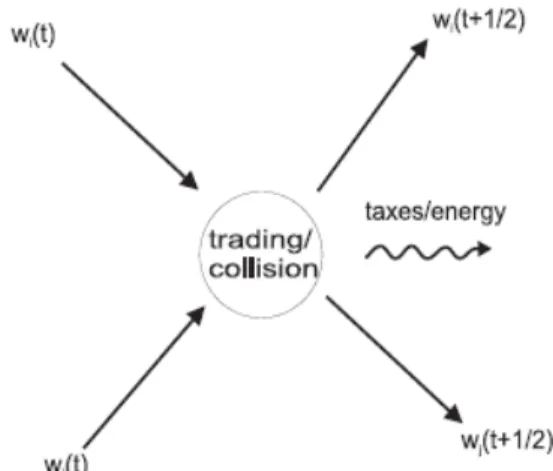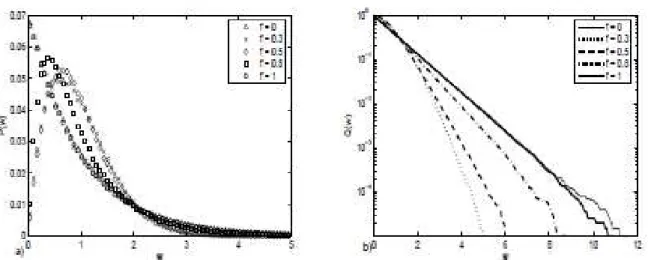TAXES IN A WEALTH DISTRIBUTION MODEL BY
INELASTICALLY SCATTERING OF PARTICLES
Sebastian Guala
Universidad Nacional de General Sarmiento Buenos Aires, Argentina
Regular paper Received: 23. February 2009. Accepted: 6. May 2009.
ABSTRACT
In this work we use an inelastic scattering process of particles to propose a model able to reproduce the salient features of the wealth distribution in an economy by including taxes to each trading process and redistributing that collected among the population according to a given criterion. Additionally, we show that different optimal levels of taxes may exist depending on the redistribution criterion.
KEY WORDS
wealth distribution, inelastic collisions
CLASSIFICATION
INTRODUCTION
More than a century ago Pareto [1] proposed a law of distribution of individual wealth in a society. It states that the tail of the wealth distribution follows a power-law P(w) ~ w−(1 + ν). Here, P(w) is the amount of people possessing wealth w. The exponent ν is the Pareto exponent and generally takes values between 1 and 3 [2, 4, 5]. It is also known that for low and medium income, P(w) decays exponentially or in a log-normal way [2–4]. Since the same behaviour was found for income distribution in a society [6, 7], in the following and for the sake of concreteness, we will refer to “wealth”, but “income” should be equally applicable.
As a consequence of the analysis of wealth and income distributions in different societies from available real data [6], it is well-known now that the distribution of the richest 5 % of the population has a power-law tail [2, 4, 5], while the majority (around 95 %) low-income distribution fits well to Gibbs or log-normal form [8]. There has been several attempts to model a simple economy [9–23], which involve a wealth exchange process that produces a distribution of wealth similar to that observed in real economies. Most of works are particularly interested in microscopic models of markets where the economic activity is considered as a scattering process. The models centred on savings in the trading process received special attention [6–8], which reproduce features of real wealth distributions. This type of models is analogously thought as either elastically or inelastically scattering particles. Inelastic scattering of particles was studied in the context of granular materials [24–26] by the inelastic variant of the Maxwell model [27–30].
The conclusion of these studies is that a self-similar solution of the kinetic equations exist, which is not stationary in time at individual level, but the system converges to time-independent parameters. The model introduced here studies how inelastic binary collisions may be assumed as the application of taxes. Its redistribution can reproduce the salient features of empirical distributions of wealth without regard to, in principle, any another consideration. Based on the aforementioned saving models and from the majority log-normal distribution point of view, we propose a simple granular closed-system model in which the collisions are inelastic and the loss of energy is eventually redistributed among the particles of the system according to certain state” criterion.
A parallel aim of this work is to evaluate the response of the simple model when the scope of feasible rules is extended to include taxes, specially related to income distribution, according to realistic observations.
THE MODEL
Imagine a closed economic system with total amount of money (wealth) W and total number N of agents, both constant. It is, neither production nor death/birth of agents occurs. The only economic activity is confined to trading. Agent i possess a wealth wi(t) at time t. Time changes after each trading. Any trading involves two steps: first, two randomly chosen agents i and j exchange their money in “inelastic” way such that a fraction of their exchanged wealth is lost by taxes (Figure 1):
Figure 1. Schematic picture of the first step of the scattering process. Agents i and j exchange their wealth in the economy and for their exchanges pay taxes, which are redistributed among the population.
with wi(t), wj(t), wk(t) ≥ 0 for all i, j, k and t; f is the fraction of trading lost by taxes and bij is a random fraction (0 ≤bij≤ 1). Secondly, taxes are redistributed among individuals according to a certain rule (i.e., equally distributed among the population, distributed among the poorest fraction, etc.): ⎪⎩ ⎪ ⎨ ⎧ + ∀ ∈ + + = + otherwise. , 0 , )], ( ) ( [ | | ) ( ) 1
( 21 w t w t r S
S f t
w t
w i j
r r
for S being the subset of population benefited by the redistribution policy; conserving the total wealth:
∑
= N i i t wW ( . )
From now on, we will use P(w) normalized as a probability distribution function of wealth w. As we can see here, at f = 0 the steady-state wealth distribution of the economy becomes a Gibbs’ one as reported in [31], with modal value wm = 0. For S = N and f ≠ 0 (i.e., when all the agents are equally benefited by the redistribution), the equilibrium distribution becomes asymmetric unimodal with wm of P(w) shifting away from wm = 0, reaching a maximum wm and moving back to wm = 0 as f → 1, as shown in Figure 2.a. In this organization of the economy induced by taxes with a global egalitarian perspective is very significant the way in which the fraction of paupers decreases until certain level of taxes and most people end up close to the average wealth in the economy. In this sense, slopes of the log-normal cumulative probability Q(w), defined as
∫
∞ = w w d w P wQ( ) (ˆ) ˆ,
Figure 2. a) Wealth distribution P(w) and b) cumulative probability Q(w) for different taxes f;
N = 1000 and average wealth W/N = 1.
We proposed a new rule for the simple binary trading model in the search of adding further complexities, which might appear in real economies. Besides, by this work we evaluated the robustness of that model for allowing other potentially-realistic rules, holding the same qualitative behaviour. In this case, a granular model was analyzed in which inelastic binary collisions were consider in a closed system where the after-collision lost energy is captured by the molecules in it with the aim of emulating taxes paid in each trade operation and then redistributed by the corresponding State. Observations have been made about the wealth distribution obtained fitted as a log-normal one. The optimum level of taxes f≈ 0,325 shows a more egalitarian economy for a model with non-selective redistribution. In the case where the redistribution is focused on the poorest individuals we observed a significant majority with wealth around the average one.
Further research in this sense should be centred in an analytical treatment of the model and in more complex instances which include simultaneously taxes into the well-known models of saving propensity, binary trading according to the possibilities of the poorest agent of both, evasion propensity according to level of taxes, etc., in order to get models from a comprising conception.
REFERENCES
[1] Pareto, V.: Cours d’economie Politique. F. Rouge, Lausanne, 1897,
[2] Levy, M. and Solomon, S.: New evidence for the power-law distribution of wealth. Physica A 242, 90–94, 1997,
[3] Dragulescu, A. and Yakovenko, V.M.: Evidence for the exponential distribution of income in the USA.
European Physical Journal B 20, 585–589, 2001,
[4] Banerjee, A.; Yakovenko, V.M. and Di Matteo, T.: A study of the personal income distribution in Australia.
Physica A 370, 54–59, 2006,
[5] Sinha, S.: Evidence for power-law tail of the wealth distribution in India. Physica A 359, 555–562, 2006,
[6] Chatterjee, A.; Yarlagadda, S. and Chakrabarti, B.K., eds.: Econophysics of Wealth Distributions.
Springer Verlag, Milan, 2005,
[7] Chakrabarti, B.K.; Chakraborti, A. and Chatterjee, A., eds.: Econophysics and Sociophysics.
Wiley-VCH, Berlin, 2006,
[8] Chatterjee, A. and Chakrabarti, B.K.: Kinetic exchange models for income and wealth distributions.
European Physical Journal B 60, 135–149, 2007,
[9] Chatterjee, A. and Chakrabarti, B.K.: Ideal-gas-like market models with savings: Quenched and annealed cases.
Physica A 382, 36–41, 2007,
[10]Ausloos, M.A. and Pekalski, A.: Model of wealth and goods dynamics in a closed market. Physica A 373, 560–568, 2007,
[11]Matthes, D. and Toscani, G.: On Steady Distributions of Kinetic Models of Conservative Economies.
Journal of Statistical Physics 130, 1087–1117, 2008,
[13]Chattopadhyay, A.K. and Mallick, S.K.: Income distribution dependence of poverty measure: A theoretical analysis.
Physica A 377, 241–252, 2007,
[14]Bouchaud, J.P. and Mézard, M.; Wealth condensation in a simple model of economy. Physica A 282, 536–545, 2000,
[15]Cordier, S.; Pareschi, L. and Toscani, G.: On a Kinetic Model for a Simple Market Economy. Journal of Statistical Physics 120, 2005,
[16]Pianegonda, S. and Iglesias, J.R.: Inequalities of wealth distribution in a conservative economy.
Physica A 342, 193–199, 2004,
[17]Patriarca, M.; Chakraborti, A. and Germano, G.: Influence of saving propensity on the power-law tail of the wealth distribution.
Physica A 369, 723–736, 2006,
[18]Garlaschelli, D. and Loffredo, M.I.: Wealth dynamics on complex networks. Physica A 338, 113–118, 2004,
[19]Bogojević, A.; Balaž, A. and Karapandža, R.: Consequences of increased longevity for wealth, fertility, and population growth.
Physica A 387, 543–550, 2008,
[20]Pianegonda, S.; Iglesias, J.R.; Abramson, G. and Vega, J.L.: Wealth redistribution with conservative exchanges.
Physica A 322, 667–675, 2003,
[21]Pareschi, L. and Toscani, G.: Self-Similarity and Power-Like Tails in Nonconservative Kinetic Models.
Journal of Statistical Physics 124, 2006,
[22]Iglesias, J.R. et al.: Wealth redistribution in our small world. Physica A 327, 12–17, 2003,
[23]Scafetta, N.; Picozzi, S. and West, B.J.: A trade-investment model for distribution of wealth.
Physica D 193, 338–352, 2004,
[24]Repetowicz, P.; Hutzler, S. and Richmond, P.: Dynamics of money and income distributions.
Physica A 356, 641–654, 2005,
[25]Slanina, F.: Inelastically scattering particles and wealth distribution in an open economy. Physical Review E 69, No. 046102, 2004,
[26]Jaeger, H.M.; Nagel, S.R. and Behringer, R.P.: Granular Solids, Liquids, and Gases. Reviews of Modern Physics 68, 1259–1273, 1996,
[27]Bobylev, A.V. and Cercignani, C.: Self-similar asymptotics for the Boltzmann equation with inelastic and elastic interactions.
Journal of Statistical Physics 110, 333–375, 2003,
[28]Ben-Naim, E. and Krapivsky, P.L.: Scaling, multiscaling, and nontrivial exponents in inelastic collision processes.
Physical Review E 66, 011309, 2002,
[29]Ernst, M.H. and Brito, R.: High-energy tails for inelastic Maxwell models. Europhysics Letters 58, 182–187, 2002,
[30]Barkai, E.: Stable equilibrium based on Levy statistics: Stochastic collision models approach. Physical Review E 68, No. 055104, 2003,
[31] Chatterjee, A.; Chakrabarti, K. and Manna, S.S.: Money in Gas-Like Markets: Gibbs and Pareto Laws.
POREZI U MODELU RASPODJELE BOGATSTVA
TEMELJENOM NA NEELASTI
Č
NOM
RASPRŠENJU
Č
ESTICA
S. Guala
Nacionalno sveučilište generala Sarmienta Buenos Aires, Argentina
SAŽETAK
U ovom radu koristimo procese neelastičnog raspršenja čestica za postavljanje modela koji može reproducirati temeljna svojstva raspodjele bogatstva u ekonomiji. Pritom je svaki proces trgovine praćen porezima koji se naknadno raspodijeljuju unutar populacije prema zadanom kriteriju. Dodatno, pokazujemo kako mogu postojati različite optimalne razine poreza u ovisnosti o kriteriju raspodjele.
KLJUČNE RIJEČI

